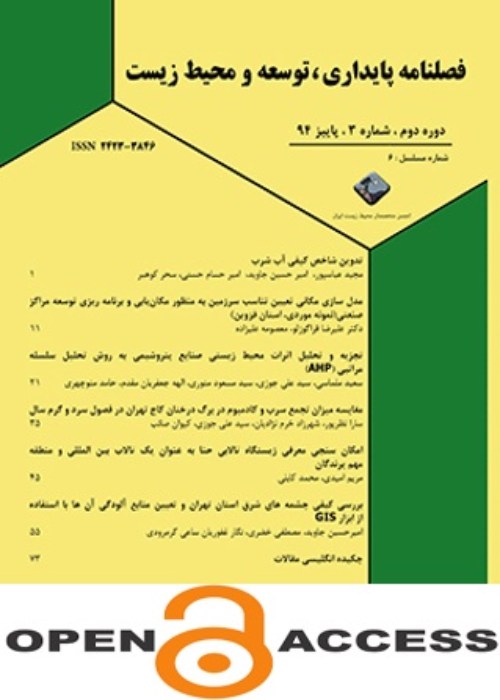Waste management of Food industries in Rasht
Author(s):
Abstract:
Rasht, as the center of Gilan province, has the highest number of food industries and since these industries in the northern part of the country, especially Gilan are the most dominant existing ones, it seemed necessary to study management conditions of the food industries residuals through observation and filling in topic questionnaires in 40 active industrial units in Rasht. As the first step in this research, the food industries of the city were identified and classified based on their products. Then, active units were specified and their residuals management status was studied. Next, obtained data were analyzed using statistical softwares such as SPSS and other softwares were used for drawing relevant tables and diagrams. To study the quality of residuals and their compositions in each food industry group, the temporary storage places were surveyed and through filling in the questionnaires by those in charge the physical analysis of the residuals and the production levels were reviewed the results of which are as follows: Studies showed that the majority of food industries in Rasht did not pay close attention to environmental aspects, particularly the management of their residuals; they did not observe environmental regulations; they considered the cooperation of environment experts costly and problematic and often would not take any measure to analyze their residuals. It is noteworthy that among all food industries of the city only one of them was selected as the Green Industry.
It was also found that bread, biscuit and drinks producing groups had the highest level of industrial wastes while bread, biscuit and drinks producing groups showed the highest level of domestic wastes. About 63% of the wastes from industrial residuals were recyclable; however only were practically recycled. The most frequent waste disposal methods exercised by the industries were selling (45.6%) and hygienic burying (32%). In addition, some industries burned a part (4.3%) of their wastes in a nonstandard way. The common way of keeping wastes until disposal was open stores in the factory that in itself could cause pollution. The major source of industrial wastes in food industries could be said to be from products (24.32%) and then those of packaging (20.58%). Moreover, the time periods of waste disposal in 48.2% of industries were case disposals and 15.4% of them were reported on a daily basis.
It was also found that bread, biscuit and drinks producing groups had the highest level of industrial wastes while bread, biscuit and drinks producing groups showed the highest level of domestic wastes. About 63% of the wastes from industrial residuals were recyclable; however only were practically recycled. The most frequent waste disposal methods exercised by the industries were selling (45.6%) and hygienic burying (32%). In addition, some industries burned a part (4.3%) of their wastes in a nonstandard way. The common way of keeping wastes until disposal was open stores in the factory that in itself could cause pollution. The major source of industrial wastes in food industries could be said to be from products (24.32%) and then those of packaging (20.58%). Moreover, the time periods of waste disposal in 48.2% of industries were case disposals and 15.4% of them were reported on a daily basis.
Keywords:
Language:
Persian
Published:
Journal of Sustainability, Development and Environment, Volume:3 Issue: 1, 2016
Pages:
35 to 45
magiran.com/p1690926
دانلود و مطالعه متن این مقاله با یکی از روشهای زیر امکان پذیر است:
اشتراک شخصی
با عضویت و پرداخت آنلاین حق اشتراک یکساله به مبلغ 1,390,000ريال میتوانید 70 عنوان مطلب دانلود کنید!
اشتراک سازمانی
به کتابخانه دانشگاه یا محل کار خود پیشنهاد کنید تا اشتراک سازمانی این پایگاه را برای دسترسی نامحدود همه کاربران به متن مطالب تهیه نمایند!
توجه!
- حق عضویت دریافتی صرف حمایت از نشریات عضو و نگهداری، تکمیل و توسعه مگیران میشود.
- پرداخت حق اشتراک و دانلود مقالات اجازه بازنشر آن در سایر رسانههای چاپی و دیجیتال را به کاربر نمیدهد.
دسترسی سراسری کاربران دانشگاه پیام نور!
اعضای هیئت علمی و دانشجویان دانشگاه پیام نور در سراسر کشور، در صورت ثبت نام با ایمیل دانشگاهی، تا پایان فروردین ماه 1403 به مقالات سایت دسترسی خواهند داشت!
In order to view content subscription is required
Personal subscription
Subscribe magiran.com for 70 € euros via PayPal and download 70 articles during a year.
Organization subscription
Please contact us to subscribe your university or library for unlimited access!


